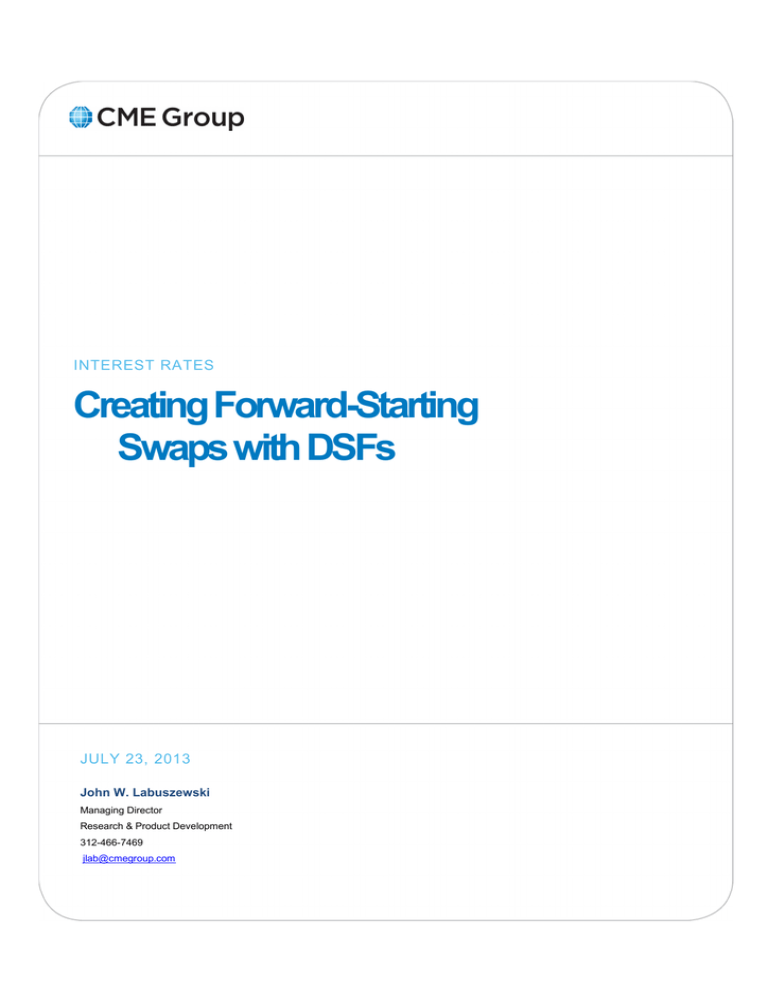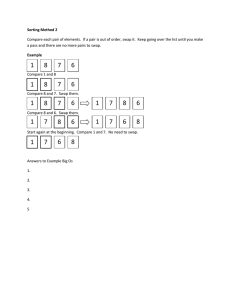
INTEREST RATES
Creating Forward-Starting
Swaps with DSFs
JULY 23, 2013
John W. Labuszewski
Managing Director
Research & Product Development
312-466-7469
jlab@cmegroup.com
CME Group introduced its Deliverable Swap Futures
(DSFs) contracts to an outstanding reception in late
2012. These products are futures contracts, offered
on the Chicago Board of Trade (CBOT), that call for
the delivery of an over-the-counter (OTC) interest
rate swap (IRS) instrument that is cleared and
carried on the books of the Chicago Mercantile
Exchange (CME) Clearing House.
In the relatively short time in which they have been
made available, DSFs have been broadly embraced
by financial institutions as an innovative new
method of creating risk exposures that parallel that
of OTC IRS instruments.
DSFs offer significant
capital efficiencies to the extent that they are
eligible for cross-margining offsets vs. other CME
Group interest rate products; and, offer reduced
margin requirements relative to cleared IRS
instruments.
contracts that call for the delivery of IRS
instruments.2 The deliverable IRS instruments are
standardized or plain-vanilla swaps that are cleared
and carried through the facilities of the CME Clearing
House.
Separate DSFs are available that call for the delivery
of a 2-, 5-, 10- or 30-year term IRS instrument with
a notional value of $100,000. Contracts are listed
for delivery on the Monday preceding the 3rd
Wednesday of the contract months of March, June,
September and December.
The buyer or long of a DSF becomes the fixed rate
receiver (floating rate payer) of the swap upon
delivery. Thus, the long DSF position will benefit
from falling rates (rising prices).
Reference Convention
DSF
Position
Buyer
(Long)
Seller
(Short)
Swap Rates
7%
6%
5%
Delivered Swap Position
Fixed Rate Receiver
(or Floating Rate Payer)
Fixed Rate Payer
(or Floating Rate Receiver)
4%
The seller or short of a DSF becomes the fixed rate
payer (floating rate receiver) upon delivery of the
swap. Thus, the short DSF position will benefit from
rising rates (falling prices).
3%
2%
1%
2-Yr Swap
10-Yr Swap
Jan-13
Jan-12
Jan-11
Jan-10
Jan-09
Jan-08
Jan-07
Jan-06
Jan-05
Jan-04
Jan-03
Jan-02
Jan-01
0%
5-Yr Swap
30-Yr Swap
But it is their functionality and application that is
paramount to their success. This article discusses
how combinations of Deliverable Swap Futures may
be deployed effectively to create forward-starting
swap exposures
DSF Primer
The floating rate associated with the delivered swap
is based on the ICE Benchmark Administration
Limited (ICE) 3-month LIBOR fixing, or the same
rate that is used to settle CME Eurodollar futures
contracts. Each contract calls for the delivery of a
swap with a specified fixed rate or coupon that is
established
by
the
Exchange
generally
to
approximate market rates at the time of listing, e.g.,
0.5%, 1.0%, 1.5%, 2.0%, etc.
These products are quoted as 100% of par plus nonpar value (NPV) of the deliverable swap instrument
in percent of par. NPV may be assessed as the
As a preamble, let us review the salient features of
Deliverable Swap Futures.1
DSFs are futures
For a more detailed discussion of the contract terms
and conditions of DSFs and a broad review of their
applications, please see “Understanding Deliverable
Swap
Futures”
which
may
be
found
at
http://www.cmegroup.com/trading/interestrates/understanding-dsf.html
To participate in a physical delivery, a futures position
holder must be an Eligible Contract Participant (ECP) as
defined in the Commodity Exchange Act and CME Rule
90005.C., and must be registered with CME by a CME
IRS Clearing Member as an IRS Participant per CME
Rules 90005.A. and 90005.B.
Creating Forward-Starting Swaps with DSFs | July 23, 2013
| © CME GROUP
2
1
1
present value of the future stream of fixed rate
payments less the present value of the floating rate
payments. The NPV of a swap may be positive or
negative depending upon the relationship of
prevailing swap (fixed) rates and the fixed rate or
coupon associated with the DSF.
Rates > DSF Coupon
NPV is negative (-)
& DSF Quote < Par
Rates < DSF Coupon
NPV is positive (+)
& DSF Quote > Par
Thus, DSFs may be quoted above 100% of par, e.g.,
101%, 102%, 103%, etc., if prevailing rates are
greater than the DSF coupon rate. Or, DSFs may be
quoted below par, e.g., 99%, 98%, 97%, etc., if
prevailing rates are less than the DSF coupon rate.
Building a Forward Swap
Combinations of 2-, 5-, 10- and 30-year DSF futures
may be traded effectively to create positions in
forward-starting swaps of different tenors.
A
forward starting swap may be thought of as an
interest rate swap that is entered into at a specified
future date. E.g., one may wish to enter into a 5year swap 5 years from the current date. 3
As a general rule, if one BUYS the shorter-tenure
DSF and SELLS the longer-tenure DSF, the trader
becomes the fixed rate payer (or floating rate
receiver).
Using the reference conventions as
described above, we would say that the trader has
sold or is short the forward-starting swap.
BUY S-T &
SELL L-T DSF
=
SHORT forward-starting swap
(fixed rate payer or
floating rate receiver)
SELL S-T &
BUY L-T DSF
=
LONG forward-starting swap
(fixed rate receiver or
floating rate payer)
rate receiver (floating rate payer) and is said to
have bought or is long the forward starting swap.
To understand, consider what happens if one were
to buy one 5-year DSF and sell one 10-year DSF
with the same coupon. Upon delivery, the trader
becomes the fixed rate receiver of a 5-year swap;
and, the fixed rate payer of a 10-year swap.
During the first 5 years of this transaction, the
floating rate and the fixed rate payments are
identical but opposite for the two swap instruments.
Thus, the fixed and floating rate payments on both
swaps offset each other perfectly
But after the first 5 years, the 5-year swap expires,
leaving the trader as the fixed rate payer of 10-year
swap whose term has dwindled down to 5 years.
I.e., the trader becomes the fixed rate payer
(floating rate receiver) of swap with 5 years
remaining until expiration. Thus, the trader has
effectively sold a 5-year swap on a five-year forward
starting basis.
If the trader had sold one 5-year DSF and bought
one 10-year DSF with the same coupon, the
opposite occurs. After the first 5 years, the 5-year
swap expires, leaving the trader as the fixed rate
receiver of a 10-year swap with a remaining term of
5 years. I.e., the trader is the fixed rate receiver
(floating rate payer) of a swap with 5 years to
maturity.
Or, we can say that the trader has
effectively bought a 5-year swap on a five-year
forward starting basis.
Because CME offers DSFs that call for the delivery of
2-, 5-, 10- and 30-year swaps, it is theoretically
possible to create a variety of forward starting
swaps.
The various combinations that may be
engineered are described in the table below.
If one SELLS the shorter-tenure DSF and BUYS the
longer-tenure DSF, the trader will become the fixed
Creating Forward-Starting Swaps
2-Year
DSF
5-Yr DSF
3-Year Swap
2 Years
Forward
5-Year
DSF
3
2
Of course, DSFs are a form of forward-starting swaps in
the sense that they call for the future delivery of an IRS
instrument. But DSFs are only listed for delivery going
out a couple of quarters in advance.
The strategy
described herein allows one to create much longer-term
forwards.
Creating Forward-Starting Swaps with DSFs | July 23, 2013
10-Year
DSF
| © CME GROUP
10-Yr DSF
8-Year Swap
2 Years
Forward
5-Year Swap
5 Years
Forward
30-Yr DSF
28-Year Swap
2 Years
Forward
25-Year Swap
5 Years
Forward
20-Year Swap
10 Years
Forward
E.g., the combination of a 5- and 10-year DSF can
be used to create a 5-year swap on a five-year
forward starting basis.
period that is acquired through channels apart from
the DSF delivery mechanism in order to address this
issue.
E.g., the combination of a 2- and 5-year DSF can be
used to create a 3-year swap on a two-year forward
starting basis.
Yield Curve Play
E.g., the combination of a 10- and 30-year DSF can
be used to create a 20-year swap on a ten-year
forward starting basis.
Coupon Considerations
This strategy works best if the coupons associated
with both DSFs that comprise the original
transaction match identically. If this condition is
met, then the cash flows on the long and short
swaps during the forward period of the transaction
are perfectly offset and the position becomes a
“clean” forward starting swap.
E.g., assume you buy one 5- and sell one 10-year
DSF, both with coupons of 1%, and go through the
delivery process. For the subsequent five years, the
semi-annual fixed coupon payments on the two
positions equals $500 (=0.01% x $100,000 face
value) and offset precisely. Likewise, the quarterly
floating rate payments tied to the 3-month LIBOR
rate and based on $100,000 face value also match
and offset precisely.
But if the coupons of the two DSFs are not
equivalent, then there will be cash flow mismatches
during the forward starting period. For example, for
the December 2013 delivery, coupons are available
at ½% for 2-year DSFs; 1-½% for 5-year DSFs; 2½% for 10-year DSFs; and, 3-¼% for 30-year
DSFs.
Finally, we add that the combination of long and
short DSF positions based on varying tenor swaps
may be traded as a form of yield curve play.
E.g., if one believed that the forward swap curve
would steepen, one might buy short-term and sell
long-term DSFs, i.e., “buy the yield curve.”
E.g., if one believed that the forward swap curve
would flatten or invert, one might sell short-term
and buy long-term DSFs, i.e., “sell the yield curve.”
In order to utilize DSFs in this fashion, it is
obligatory to weight the transaction by reference to
the relative basis point values (BPVs) associated
with each leg of the spread. But that is another
discussion.
Conclusion
DSF contracts represent a powerful and versatile
new trading and risk-management vehicle.
The
product may be deployed in a variety of practical
applications including use as a substitute for actual
IRS market exposures; a hedge vs. current or
anticipated IRS holdings; a hedge or spread vs. cash
Treasury securities or Treasury futures.
Or, they
may be used to create longer-term forward-starting
interest rate swap positions as described herein.
To learn more about this contract, please visit our
website at www.cmegroup.com/dsf.
One may attempt to weight the trade by putting on
a position using unequal numbers of contracts in
order to equalize the fixed rate payments during the
forward starting period.
E.g., one might match five 1-½% coupon 5-year
DSFs with three 2-½% coupon 10-year DSFs. This
equalizes the fixed payments but leaves the floating
rate payments unbalanced.
It is also possible to supplement the transaction with
a cleared swap position during the forward starting
3
Creating Forward-Starting Swaps with DSFs | July 23, 2013
| © CME GROUP
Deliverable Swap Futures (DSF) Specifications
Trading Unit
Delivery Months
Contract
Fixed Rate
Quote Convention
Minimum Price
Increment
Last Trading Day
Delivery Day
Delivery Standard
A $100,000 notional face value Interest Rate Swap (IRS), cleared by CME Clearing House,
with tenors of 2-, 5-, 10- or 30-years, exchanging semiannual fixed interest
payments at a rate per annum equal to Contract Fixed Rate for quarterly floating
interest rate payments based on 3-month London interbank offered rate.
March, June, September or December
Established by Exchange at integer multiples of
25 basis points with 30/360 day count fraction
Prices quoted in % of par: 100 points + non-par value (NPV) of
IRS where NPV is present value of IRS fixed-rate payments minus
present value of IRS floating-rate payments as of Delivery Day
2-Year
1/4th of 1/32nd of 1% of $100,000 ($7.8125)
5- and 10-Year
½ of 1/32nd of 1% of $100,000 ($15.625)
30-Year
1/32nd of 1% of $100,000 ($31.25)
Trading in expiring futures terminates at 2 pm (CT) on 2nd London
business day before 3rd Wednesday of futures Delivery Month
3rd Wednesday of Delivery Month
Fixed Rate Payer is “short” and “makes” delivery
Reference Conventions
Floating Rate Payer is “long” and “takes” delivery
Reference Tenors
2-, 5-, 10- and 30-Year IRS Instruments
Notional Amount
$100,000 (USD) per futures contract
IRS Effective Date
3rd Wednesday of Delivery Month
Termination Date
Anniversary of IRS Effective Date at futures Reference Tenor
Fixed Pay Dates
Semiannually from IRS Effective Date on 30/360 day count
Established by Exchange at
Fixed Rate
integer multiples of 25 basis points
Floating Pay Dates
Quarterly from IRS Effective Date on Actual/360 day count
Floating Rate Reference
ICE 3-Month USD LIBOR with no spread or compounding
Physical delivery of IRS per Delivery Standard with Clearing Acceptance Date and Clearing
Effective Date = 1st Business Day preceding 3rd Wednesday of Delivery Month
Invoice Price = IRS Initial Payment Amount, per Final Settlement Price (P)
Delivery Method
Delivery Eligibility
Trading Hours
and Venue
If 100 < P, then IRS Floating Rate Payer pays, and IRS Fixed Rate Payer receives,
$1,000 x ( P – 100 ) per contract, rounded to nearest penny
If P ≤ 100, then IRS Fixed Rate Payer pays, and IRS Floating Rate Payer receives,
$1,000 x ( 100 – P ) per contract, rounded to nearest penny
Limited to Eligible Contract Participants (ECPs) per Section 1a(18) of the Commodity
Exchange Act and registered with CME by CME IRS Clearing Member as IRS Participant.
CME Globex
5:00 pm to 4:00 pm, Sun-Fri
Open Outcry
7:20 am to 2:00 pm, Mon-Fri
Copyright 2013 CME Group All Rights Reserved. Futures trading is not suitable for all investors, and involves the risk of loss. Futures
are a leveraged investment, and because only a percentage of a contract’s value is required to trade, it is possible to lose more than the
amount of money deposited for a futures position. Therefore, traders should only use funds that they can afford to lose without affecting
their lifestyles. And only a portion of those funds should be devoted to any one trade because they cannot expect to profit on every
trade. All examples in this brochure are hypothetical situations, used for explanation purposes only, and should not be considered
investment advice or the results of actual market experience.
Swaps trading is not suitable for all investors, involves the risk of loss and should only be undertaken by investors who are ECPs within the
meaning of Section 1(a)18 of the Commodity Exchange Act. Swaps are a leveraged investment, and because only a percentage of a
contract’s value is required to trade, it is possible to lose more than the amount of money deposited for a swaps position. Therefore, traders
should only use funds that they can afford to lose without affecting their lifestyles. And only a portion of those funds should be devoted to
any one trade because they cannot expect to profit on every trade.
CME Group is a trademark of CME Group Inc. The Globe logo, E-mini, Globex, CME and Chicago Mercantile Exchange are trademarks of
Chicago Mercantile Exchange Inc. Chicago Board of Trade is a trademark of the Board of Trade of the City of Chicago, Inc. NYMEX is a
trademark of the New York Mercantile Exchange, Inc.
The information within this document has been compiled by CME Group for general purposes only and has not taken into account the
specific situations of any recipients of the information. CME Group assumes no responsibility for any errors or omissions. All matters
pertaining to rules and specifications herein are made subject to and are superseded by official CME, CBOT and NYMEX rules. Current
CME/CBOT/NYMEX rules should be consulted in all cases before taking any action.
4
Creating Forward-Starting Swaps with DSFs | July 23, 2013
| © CME GROUP



